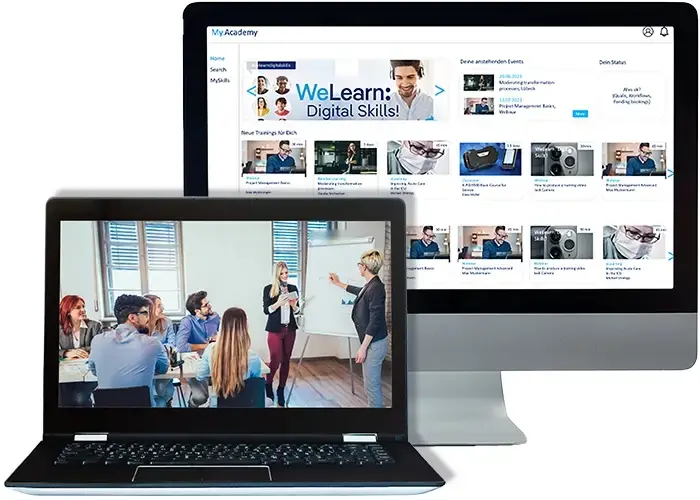Break-Even Point of a Learning Management System (LMS): When Does the Investment Pay Off?

We provide you with a comprehensive guide to calculating the break-even point for a Learning Management System (LMS). It explains which costs and savings you should consider and how to assess the profitability of an LMS based on these factors.
With practical formulas and examples, the text offers valuable insights to help you clearly understand the benefits of an LMS and make an informed investment decision. Gain practical knowledge that allows you to accurately plan long-term savings and efficiency gains for your company.
1. What is the Break-Even Point of an LMS?
The Break-Even Point (BEP) marks the point at which the savings and benefits of a Learning Management System (LMS) surpass the initial investment and ongoing operational costs. For companies, the Break-Even Point is a crucial metric to assess when the LMS implementation becomes profitable.
It is typically calculated by comparing costs and potential savings. Both one-time and ongoing costs, as well as the various forms of savings that an LMS can generate, need to be taken into account.
2. One-Time vs. Ongoing Costs
The first step in calculating the Break-Even Point is identifying the total cost of the LMS. These costs can be broken down into one-time and ongoing expenses:

One-Time Costs:
- Acquisition costs: This includes the licensing fees for the LMS software, potential hardware requirements, and customization costs to integrate the LMS into the existing IT infrastructure.
- Implementation costs: This covers configuration, integration, and data migration. These costs may also include external consultants or IT specialists.
- Employee training: To ensure all employees can effectively use the LMS, training is required. These costs are incurred once but may vary depending on the complexity of the system.
- Project management and consultancy: Implementing an LMS often requires significant planning and management efforts, especially for companies with limited experience in rolling out such systems.
Ongoing Costs:
- License fees: Particularly for cloud-based solutions, recurring licensing fees are common, often billed annually or monthly.
- Maintenance and support: Regular system upkeep, bug fixes, and continuous system improvement generate ongoing costs.
- Updates and new features: To keep the LMS up to date with current technology and evolving company needs, regular updates are necessary.
- System administration: Even after implementation, the LMS requires personnel for management, content creation, and monitoring of training data. These administrative costs must be planned for long-term operations.
3. Potential Savings from the LMS
The second important step in determining the Break-Even Point is identifying the potential savings the LMS will bring to the company. These savings can be realized in several areas:

Reduced costs for in-person training:
By using an LMS, many training sessions that were previously held as in-person events can be converted into e-learning or webinars. This leads to significant savings in:
- Travel and accommodation costs for employees and trainers.
- Venue rental and catering for training events.
Efficiency improvements:
An LMS automates administrative tasks, leading to significant time savings. Tasks such as registering participants, issuing certificates, and tracking learning progress are automated. Human error is greatly reduced through automation.
- Time savings in report generation: An LMS automatically generates reports on learning progress, completion rates, and certifications, reducing the administrative burden.
- Reduced trainer workload: Preparation and follow-up for training sessions can be optimized through an LMS, saving time, especially for repetitive content.
Scalability of the LMS:
One of the biggest advantages of an LMS is its scalability. While costs for traditional training increase with the number of participants, costs for e-learning and webinars remain relatively stable, even as more participants join.
In fact, for e-learning, no additional cost is incurred per user, which can lead to substantial savings when training needs are large.
4. Improving Learning and Business Performance through an LMS
In addition to direct savings, qualitative improvements through an LMS play a crucial role in reaching the Break-Even Point.

Improved learning quality:
An LMS offers numerous advantages in terms of learning quality:
- Faster access to training materials for all employees.
- Flexible learning: Employees can learn at their own pace and fit training into their work schedules.
- Standardization of content ensures that all employees receive the same information, maintaining consistent training quality.
Enhanced performance measurement:
By using an LMS, companies can better measure and evaluate their employees' learning progress. These data help optimize training programs and tailor them more closely to employees’ needs.
5. Break-Even Point Calculation: Formula and Example
To calculate the Break-Even Point, the total cost of the LMS is compared to the expected savings. The Break-Even Point is reached when cumulative savings exceed the LMS investment.

Explanation of the Formula:
- One-Time LMS Costs: These include all initial investments, such as purchase, implementation, and training.
- Annual Ongoing LMS Costs: These are the recurring costs for licensing, maintenance, support, and administration.
- Annual Savings from the LMS: These include reduced travel and training costs, as well as savings from improved processes and learning quality.
Example Calculation:
Let’s assume a company invests €100,000 in an LMS and has annual ongoing costs of €50,000. Through the LMS, the company saves €80,000 annually, for example, by reducing travel expenses and administrative costs.

The company would reach the Break-Even Point after approximately 1.88 years. From this point on, the savings begin to cover the investment fully, and the LMS becomes profitable.
6. Factors Affecting the Timing of the Break-Even Point
Several factors influence when a company reaches the Break-Even Point:

- Company size: The larger the company and the more employees requiring training, the faster the LMS investment pays off.
- Frequency and scope of training: Companies with a high demand for training will benefit from an LMS more quickly.
- Complexity of the training program: The more complex and extensive the training offering, the greater the potential savings through automation and scalability.
- Industry-specific regulations: Companies in regulated industries that need to document employee training frequently can particularly benefit from the automation offered by an LMS.
- Degree of digitization: Companies with a high level of IT integration can more easily implement an LMS and quickly realize its benefits.
7. Recommendations
To calculate the Break-Even Point of an LMS, companies should carefully assess total costs and compare them to potential savings. It is crucial to account for all relevant factors, from direct cost reductions to efficiency gains. Additionally, businesses should monitor specific KPIs such as Return on Investment (ROI) and the time to amortization to ensure the long-term success of the LMS.
Ready for the Future?
Requirements on Educational landscapes are is changing continuously—be prepared to implement innovative solutions and seize the opportunities that arise. Utilize the possibilities offered by modern seminar management software and LMS to optimize your offerings and meet the needs of your participants.

About Us
Since 1998 SoftDeCC is working closely with major training centers and academies. This results in a unique experience with training requirements.
Our Learning Management System TCmanager® is designed to adjust to individual corporate learning processes and address evolving challenges. More...

Free Consultancy
Discuss your Training Challenge with us.
Call +49 (0)89 / 309083930 to arrange for your free consultancy.
.webp)




